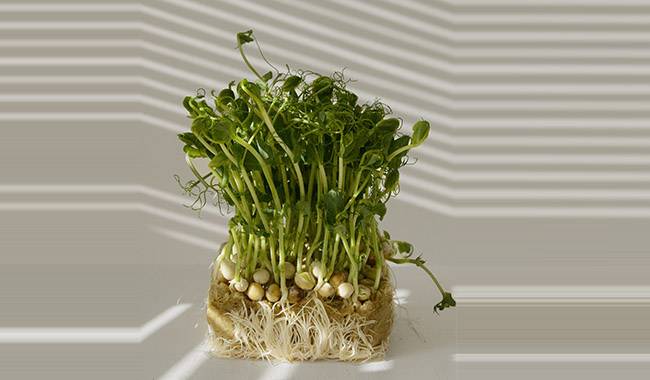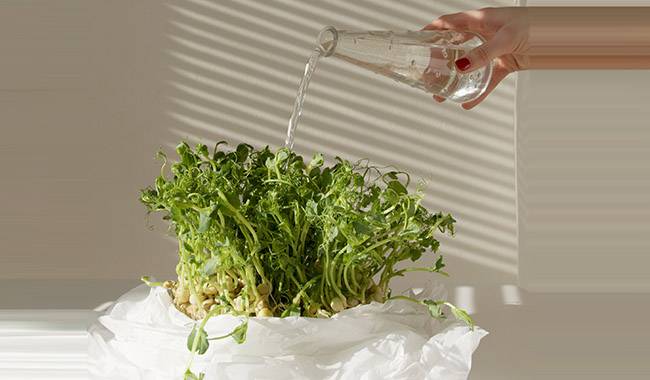
Microgreens are surprisingly for their nutritional value and practicality, have become a diet familiar to everyone who cares about healthy eating. Microgreens are a concentrate of all the nutrients that are practical, tasty, and surprisingly beautiful.
Today, Microgreens are becoming more and more available. But the freshest, healthiest Microgreens are easier to grow yourself than to buy. What’s more, when growing at home, the choice of plants is not limited to the variety available in stores.
WHAT ARE MICROGREENS?
Microgreens are sprouts of vegetables and herbs in the early stages of development, having time to put out cotyledons and first true leaves. Microgreens are the initial stage of development of edible plants and the first stage of seed growing. The concentration of nutrients, including vitamins, is the highest, 20-40 times higher than the corresponding indicators in adult plants, just at this stage.
Despite the fact that a decade or so ago no one had even heard of Microgreens, today Microgreens have become an integral part of a healthy diet. Mini sprouts, containing all the vitamins, minerals, and nutrient stocks of mature plants, not only supplement the diet with essential nutrients but also significantly change their quality.
But the value of mini-plants lies not only in their utility. Their rich taste adds a new voice to the dishes of modern cuisine.
Microgreens can replace the usual salads and greens as a superfood, a source of vitamins and minerals, and a delicious fresh additive to different dishes. It is already impossible to imagine smoothies and cocktails, many salads, gourmet and gourmet snacks without it.
Microgreens are available on almost every corner: not only in organic stores but also in regular supermarkets and vegetable stores. microgreens growing technology minimizes the risk of buying low-quality products because even on an industrial scale, only water and light are used.
But there are still certain risks :
- In most cases, such Microgreens are overgrown or have been stored in warehouses and counters for too long; immediately after cutting and at the right stage of development, you can buy Microgreens from a local, highly specialized producer.
- Ready-made Microgreens are not the most affordable pleasure.
- It is impossible to control the quality of the seeds and their ecological condition, the quality of water and soil.
There is only one way to enjoy the freshest and most useful Microgreens and to keep them constantly available – to grow them yourself. the process of growing Microgreens is the easiest option for seed germination and does not require any special skills.
NEED TO GROW MICROGREENS AT HOME?
To grow useful Microgreens independently at home, in addition to the seeds themselves and good quality pure water, you need only one thing – a container for growing. Choosing the latter is the only task.
For Microgreens you can use:
- special germination – trays for microgreens, consisting of two parts – a bottom container for water and a mesh tray for seeds with the same holes. Germination trays can be universal or prepared for several plants – different parts have holes of different diameters.
- trays and jars for germinating vegetables made of environmentally friendly materials.
- Any similar pots, containers, plastic trays, utensils.
Simply growing in water is not the only option. microgreens are often grown at home on gauze and cotton wool, burlap or sackcloth, in vermiculite, perlite, coconut fiber, or even substrate (not fertilized, from organic machines or forests).
Today, you can find everything you need to grow your own Microgreens in unlimited quantities at garden centers, florists, and even health food stores.
Modern Microgreens growing equipment, in addition to sprouts, includes.
- greenhouses for sprouting green plants.
- greenhouses in small domestic format.
- special display cabinets with lighting or full climate control.
- sets of multilayer containers and different types of inert soil and fillers.
- special professional trays with automatic watering systems and easy to rinse.
But the most convenient to use and pleasantly priced are those sets that contain only the basic elements – seeds and germination containers.
SEEDS FOR MICROGREENS
Almost every seed producer is willing to respond to the growing demand and produce a line of seeds specifically for growing Microgreens – large enough to grow several crops, or designed to provide vitamin Microgreens to families for a long time.
Professional Microgreens seeds are specially selected for home growing without any unpleasant surprises and are easy to use.
But its popularity also generates considerable costs: Microgreens seeds are often several times more expensive than ordinary seeds of the same plant, and their prices are not always reasonable. For Microgreens, you can use any purchased or your own untreated vegetable and herb seeds. Their eco-friendliness and freshness are a must.
The choice of plants to get Microgreens at home is not limited in any way, it just depends on your goals and tastes. Literally, any edible plant can be germinated.
Common Microgreens grown are:
- all kinds of lettuce, from lettuce to arugula to watercress.
- Herbs, especially basil, cilantro, and mustard.
- Sunflowers.
- corn.
- Peas, lentils, chickpeas, and other legumes (except beans).
- Radish, turnip.
- Carrots and beets.
- All types of grains – from oats to wheat and buckwheat.
- Cabbage, including broccoli, red cabbage, and leafy greens.
- onions.
You can either germinate a single plant variety or a mix of different varieties. When mixing, it is best to try to mix seeds with similar germination dates. All manufacturers have ready-made seed mixes available.
If Microgreens is used as a long-term supplement in the diet, alternate from 2 to 6 seed “cycles”.
STEP BY STEP PROCEDURE FOR GROWING MICROGREENS AT HOME

The entire process of growing a batch of “Microgreens” usually takes 5 to 10 days.
To grow your favorite Microgreens at home, you will need to.
- Soak the seeds at room temperature or slightly hot water for 2-4 hours, place them in any container in a warm place and cover them with a piece of cloth. If the swelling is slow and the seeds are large, the soaking time can be increased to 8-12 hours.
- Drain the water and rinse the seeds with water.
- If using a Germinator, fill the bottom container of the tray with water, leaving 0.4inch (1cm) to the top. Place the filled container over the top tray with the hole in the bottom.
- If Microgreens are germinating on cotton wool, gauze, or substrate, fill the selected container with a layer of soil 0.8-2inch (2-5 cm) high and gauze about 0.2inch (0.5 cm). Moisten the substrate with a sprayer.
- Spread the swollen seeds evenly in a thin layer on the substrate or gauze. The larger the seeds, the more densely they are spread. It is advisable to leave gaps between the smaller ones.
- The top of the seeds should be moistened sufficiently with a sprayer. Covering with film or glass will stabilize the humidity. Ventilate the cover daily and remove it after sprouting.
- If using sprouts, until the growing roots and reliably “fixed” seeds are contained in the mesh sprouts in a bright, warm 64-71°F (18-22°C) place. Thereafter, the plants begin to be washed two or three times a day by pulling the tops out with the sprouts and rinsing them under running water.
- Additional extra light speeds up the process, but you can simply place the container on the brightest windowsill.
- The humidity of the seeds, air, and soil should be kept constant, as well as the water level in the lower container of the double container.
- Seedlings need to be provided with fresh air circulation.
When the seedlings grow to a height of 1.6-2.7inch (4-7 cm), become more robust and the first true leaves start to develop, it is time to harvest the long-awaited Microgreens. They can be eaten immediately or stored in an airtight container in the refrigerator for a few days.
BENEFITS OF MICROGREENS
As mentioned above, the concentration of vitamins, minerals, and useful substances in Microgreens is tens of times higher than the same indicators in adult plants. Different types of Microgreens directly inherit a range of micronutrients and properties from adult plants.
If Microgreens are also managed as part of a therapeutic and preventive diet, it is worth considering the effects of the plant.
For example, lentils are better for anemia than regular cereals, radishes are better than competitors for boosting immunity, beets tone the body, sunflower is an indispensable source of protein in the diet, oats are helpful for the nervous system, broccoli acts as an anti-cancer rejuvenating additive, and so on.
But all Microgreens without exception have in common.
- Very high levels of vitamins C, A, E, K, and PP, and unique levels of vitamin D and the whole group of vitamin B, phosphorus, potassium, magnesium, and iron.
- Microgreens bring unique antioxidants and flavonoids to the diet, a full set of useful essential oils, and tannins.
- Easier to digest with fewer calories, not to mention protein and dietary fiber.
All kinds of microgreens have preventive, anti-inflammatory, and regenerative effects, improving metabolism and digestion, cardiovascular and central nervous system function, skin and hair condition, boosting immunity, and warding off aging and stress.







